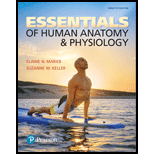
Essentials of Human Anatomy & Physiology (12th Edition)
12th Edition
ISBN: 9780134395326
Author: Elaine N. Marieb, Suzanne M. Keller
Publisher: PEARSON
expand_more
expand_more
format_list_bulleted
Concept explainers
Question
Chapter 10, Problem 15SAE
Summary Introduction
To review:
Definition of the formed elements, the category most numerous, and composition of the buffy coat.
Introduction:
Blood is the only liquid connective tissue in the body. It consists of liquid as well as solid particles, (red blood cells, white blood cells, and platelets), which constantly flow through the blood vessels. The liquid part of the blood is known as plasma. The most important liquid part of the blood is plasma, which contains 90% water, suspends blood cells and many other substances, and acts as a medium to transport medium for delivering nutrients to the cells of the various organs of the body.
Expert Solution & Answer
Want to see the full answer?
Check out a sample textbook solution
Students have asked these similar questions
State the five functions of Globular Proteins, and give an example of a protein for each function.
Diagram of check cell under low power and high power
a couple in which the father has the a blood type and the mother has the o blood type produce an offspring with the o blood type, how does this happen? how could two functionally O parents produce an offspring that has the a blood type?
Chapter 10 Solutions
Essentials of Human Anatomy & Physiology (12th Edition)
Ch. 10 - More than one choice may apply. Which would lead...Ch. 10 - Prob. 2MCCh. 10 - Prob. 3MCCh. 10 - Prob. 4MCCh. 10 - Which of the following is not typical of...Ch. 10 - Prob. 6MCCh. 10 - Prob. 7MCCh. 10 - Prob. 8MCCh. 10 - Prob. 9MCCh. 10 - Prob. 10MC
Ch. 10 - Prob. 11MCCh. 10 - Prob. 12MCCh. 10 - Prob. 13SAECh. 10 - Prob. 14SAECh. 10 - Prob. 15SAECh. 10 - Prob. 16SAECh. 10 - 17. Name the granular and agranular WBCs. Give the...Ch. 10 - Name the formed elements that arise from myeloid...Ch. 10 - Prob. 19SAECh. 10 - Describe the process of hemostasis. Indicate what...Ch. 10 - How can liver dysfunction cause bleeding...Ch. 10 - Prob. 22SAECh. 10 - Prob. 23SAECh. 10 - Prob. 24SAECh. 10 - Prob. 25SAECh. 10 - Prob. 26SAECh. 10 - Prob. 27CTCh. 10 - Prob. 28CTCh. 10 - Prob. 29CTCh. 10 - Prob. 30CTCh. 10 - Prob. 31CTCh. 10 - Prob. 32CTCh. 10 - Prob. 33CTCh. 10 - Prob. 34CTCh. 10 - Prob. 35CT
Knowledge Booster
Learn more about
Need a deep-dive on the concept behind this application? Look no further. Learn more about this topic, biology and related others by exploring similar questions and additional content below.Similar questions
- What is the opening indicated by the pointer? (leaf x.s.) stomate guard cell lenticel intercellular space none of thesearrow_forwardIdentify the indicated tissue? (stem x.s.) parenchyma collenchyma sclerenchyma ○ xylem ○ phloem none of thesearrow_forwardWhere did this structure originate from? (Salix branch root) epidermis cortex endodermis pericycle vascular cylinderarrow_forward
- Identify the indicated tissue. (Tilia stem x.s.) parenchyma collenchyma sclerenchyma xylem phloem none of thesearrow_forwardIdentify the indicated structure. (Cucurbita stem l.s.) pit lenticel stomate tendril none of thesearrow_forwardIdentify the specific cell? (Zebrina leaf peel) vessel element sieve element companion cell tracheid guard cell subsidiary cell none of thesearrow_forward
- What type of cells flank the opening on either side? (leaf x.s.) vessel elements sieve elements companion cells tracheids guard cells none of thesearrow_forwardWhat specific cell is indicated. (Cucurbita stem I.s.) vessel element sieve element O companion cell tracheid guard cell none of thesearrow_forwardWhat specific cell is indicated? (Aristolochia stem x.s.) vessel element sieve element ○ companion cell O O O O O tracheid O guard cell none of thesearrow_forward
- Identify the tissue. parenchyma collenchyma sclerenchyma ○ xylem O phloem O none of thesearrow_forwardPlease answer q3arrow_forwardRespond to the following in a minimum of 175 words: How might CRISPR-Cas 9 be used in research or, eventually, therapeutically in patients? What are some potential ethical issues associated with using this technology? Do the advantages of using this technology outweigh the disadvantages (or vice versa)? Explain your position.arrow_forward
arrow_back_ios
SEE MORE QUESTIONS
arrow_forward_ios
Recommended textbooks for you
 Anatomy & PhysiologyBiologyISBN:9781938168130Author:Kelly A. Young, James A. Wise, Peter DeSaix, Dean H. Kruse, Brandon Poe, Eddie Johnson, Jody E. Johnson, Oksana Korol, J. Gordon Betts, Mark WomblePublisher:OpenStax College
Anatomy & PhysiologyBiologyISBN:9781938168130Author:Kelly A. Young, James A. Wise, Peter DeSaix, Dean H. Kruse, Brandon Poe, Eddie Johnson, Jody E. Johnson, Oksana Korol, J. Gordon Betts, Mark WomblePublisher:OpenStax College Principles Of Radiographic Imaging: An Art And A ...Health & NutritionISBN:9781337711067Author:Richard R. Carlton, Arlene M. Adler, Vesna BalacPublisher:Cengage Learning
Principles Of Radiographic Imaging: An Art And A ...Health & NutritionISBN:9781337711067Author:Richard R. Carlton, Arlene M. Adler, Vesna BalacPublisher:Cengage Learning


Anatomy & Physiology
Biology
ISBN:9781938168130
Author:Kelly A. Young, James A. Wise, Peter DeSaix, Dean H. Kruse, Brandon Poe, Eddie Johnson, Jody E. Johnson, Oksana Korol, J. Gordon Betts, Mark Womble
Publisher:OpenStax College




Principles Of Radiographic Imaging: An Art And A ...
Health & Nutrition
ISBN:9781337711067
Author:Richard R. Carlton, Arlene M. Adler, Vesna Balac
Publisher:Cengage Learning